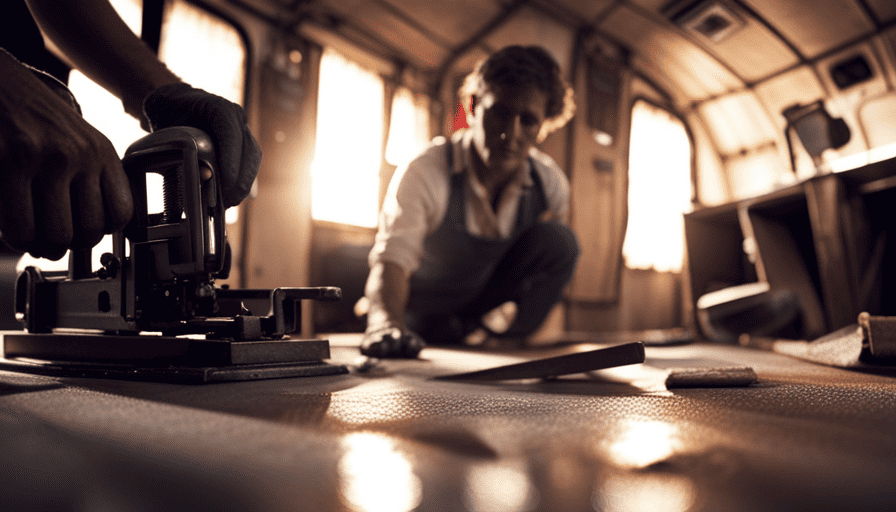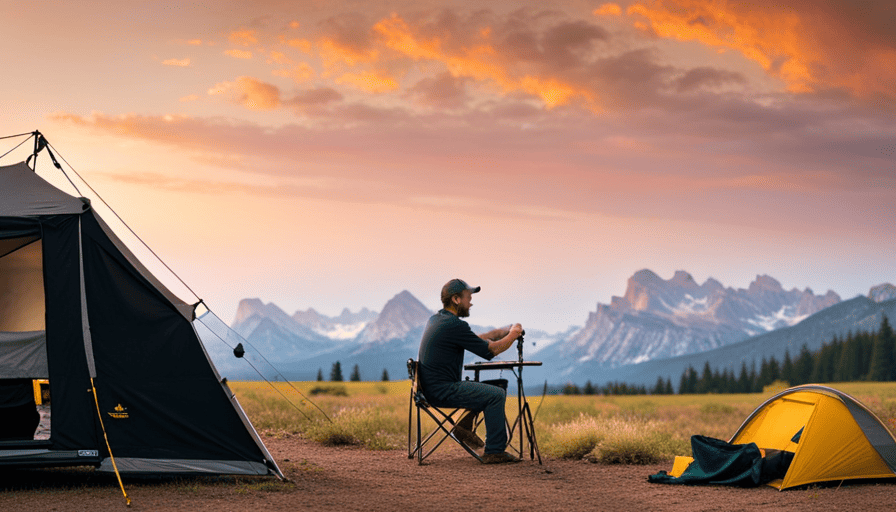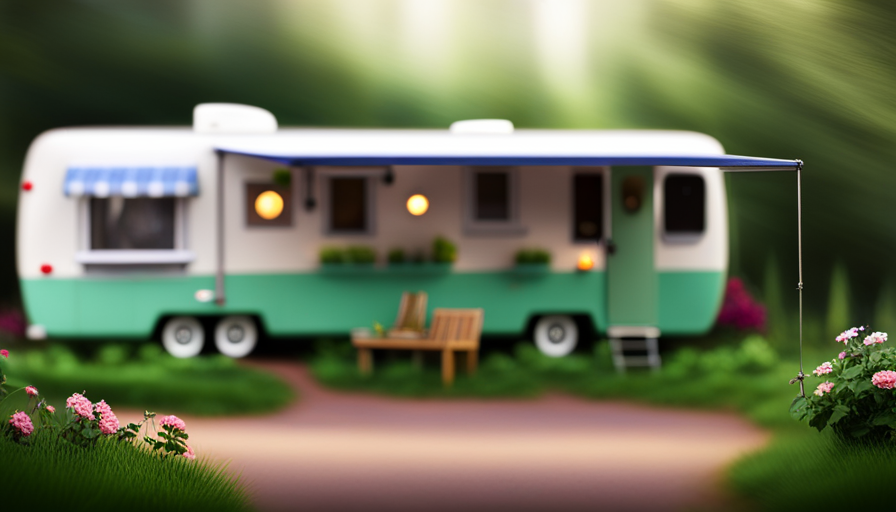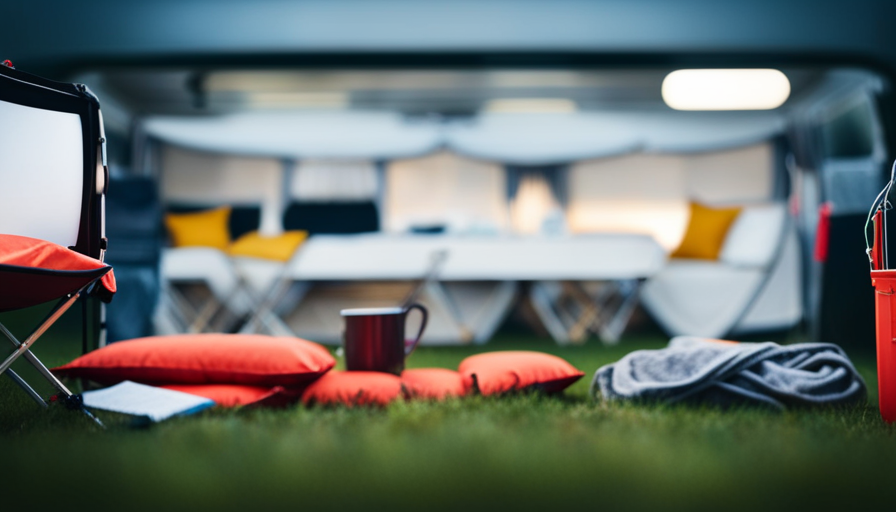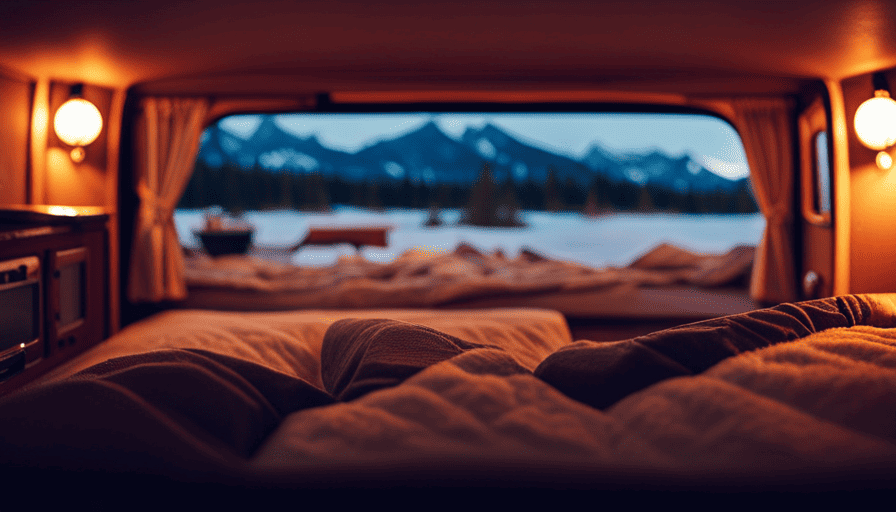Were you aware that more than 10% of people who go camping suffer from floor damage at some stage in their camping experience? If you happen to be among these unlucky individuals dealing with a damaged floor, don’t worry! I’ve got your back and will walk you through the process of repairing your camper floor, one step at a time.
In this article, I will provide you with all the necessary information and instructions to tackle this project successfully. From assessing the damage and gathering the right tools to removing the damaged flooring and installing new materials, I’ve got you covered. We’ll also explore how to repair or replace the subflooring if needed and apply finishing touches for a polished look.
Additionally, I’ll share tips on how to clean and maintain your restored floor, as well as ways to prevent future damage. By the end, you’ll have a freshly restored camper floor that will withstand the test of time and provide you with a comfortable and safe camping experience.
Let’s get started!
Key Takeaways
- Assess the extent of damage to the camper floor, including visible signs like sagging or soft spots
- Choose durable and water-resistant flooring material, such as vinyl planks, laminate flooring, or marine-grade plywood
- Properly inspect and repair the subfloor if necessary, addressing issues like rot, water damage, or structural problems
- Follow proper installation techniques, including securing the flooring in place, using underlayment for stability, and leaving expansion gaps between the flooring and walls.
Assess the Damage
Take a close look at the floor in your camper and see if there are any visible signs of damage, like sagging or soft spots. Inspecting the floor condition is crucial to determine the extent of the damage and plan the necessary repairs.
Start by identifying potential causes of damage, such as water leaks, rot, or structural issues. Look for discoloration, warping, or any areas that feel weak or spongy when stepped on. Pay attention to the edges and corners as they’re prone to damage.
To inspect the floor, use a flashlight to illuminate hard-to-reach areas and crawl underneath if possible. Look for any signs of water stains or mold, which could indicate water damage. Check the floor supports and beams for signs of decay or rust. It’s essential to thoroughly assess the floor’s condition before proceeding with repairs to ensure a long-lasting fix.
Once you’ve inspected the floor and identified the damage, it’s time to gather the necessary tools and materials for the repair. By examining the floor carefully, you’ll have a better understanding of the specific requirements for the job.
Gather the Necessary Tools and Materials
Alright, now you’re gonna wanna make sure you’ve got your hands on all the essential tools and materials for this job. Here’s a list of what you’ll need:
-
Measuring tape: This will help you accurately measure the dimensions of the floor that needs to be replaced.
-
Circular saw: A circular saw is essential for cutting the new flooring material to the correct size.
-
Pry bar: You’ll need a pry bar to remove any trim or molding that might be covering the edges of the damaged floor.
-
Drill: A drill will come in handy for removing screws or nails that are holding the damaged floor in place.
Choosing the right flooring material is crucial for a successful repair. You’ll want something durable and water-resistant. Some great options for camper floors include vinyl planks, laminate flooring, or marine-grade plywood. Make sure to consider the weight of the material as well, as you don’t want to add unnecessary weight to your camper.
Proper insulation is also important for the camper floor. It helps regulate temperature and prevents moisture build-up. Consider using closed-cell foam insulation to provide maximum insulation and moisture resistance.
With all your tools and materials ready, you’re now prepared to remove the damaged flooring and move on to the next step.
Remove the Damaged Flooring
Now, it’s time to tackle the task at hand and say goodbye to that worn-out flooring that’s been giving you headaches. Removing the damaged flooring in your camper is a crucial step in the repair process.
To start, gather your tools: a pry bar, a hammer, and a utility knife. These will help you carefully remove the old flooring without causing further damage.
Begin by inspecting the damaged area and determining the best repair method. If the damage is minimal, you may only need to replace a few planks or tiles. However, if the entire floor is compromised, you may need to consider replacing the subflooring as well.
Once you have assessed the extent of the damage, use the pry bar to gently lift the damaged flooring away from the subfloor. Take your time and be cautious to avoid any splintering or breaking. Use the utility knife to cut any adhesive or nails holding the flooring in place.
As you remove the damaged flooring, take note of the type of material used. This will help you when selecting the new flooring options. Whether you choose vinyl, laminate, or hardwood, make sure it’s suitable for the camper environment.
With the damaged flooring removed, you can now move on to the next step: repairing or replacing the subflooring if necessary.
Repair or Replace Subflooring if Necessary
If the damage to the flooring is extensive, it may be necessary to repair or replace the subflooring, which can be a challenging and time-consuming task. According to a study conducted by the National Association of Home Builders, approximately 65% of flooring repairs in homes involve the subflooring. When it comes to flooring repair techniques and DIY floor restoration, it is essential to assess the condition of the subflooring before proceeding.
To determine if the subflooring needs repair or replacement, start by removing the damaged flooring as discussed in the previous subtopic. Once the damaged flooring is removed, thoroughly inspect the subfloor for signs of rot, water damage, or structural issues. If the subflooring is weakened or compromised, it will need to be repaired or replaced before proceeding with installing new flooring.
To help you understand the extent of the damage and the necessary repairs, refer to the table below:
| Signs of Subflooring Damage | Repair/Replacement Required |
|---|---|
| Rot or Decay | Replacement |
| Water Damage | Repair or Replacement |
| Structural Issues | Replacement or Reinforcement |
By accurately assessing the subflooring condition, you can determine the appropriate course of action for your camper’s flooring repair. Once the necessary repairs or replacements are complete, you can proceed to the next step of installing new flooring.
Install New Flooring
Once you’ve determined the condition of the subflooring, it’s time to roll up your sleeves and get ready to lay down some fresh new flooring.
When it comes to installing laminate in your camper, it’s important to choose the right flooring material. Laminate is a popular choice due to its durability, easy installation, and variety of designs. It’s also resistant to moisture, making it ideal for campers that may be exposed to outdoor elements.
Before installing the laminate, ensure that the subflooring is clean and free of any debris or imperfections. Next, measure and cut the laminate pieces to fit the dimensions of your camper floor. It’s crucial to start from one corner and work your way across, ensuring a snug fit and proper alignment. Remember to leave a small gap between the laminate and the walls to allow for expansion.
Once the laminate is laid, secure the flooring in place using adhesive or click-lock systems, depending on the type of laminate chosen. This will ensure that the flooring remains stable and prevents any movement or shifting.
With the new flooring in place, you’re now ready to move on to the next step, which involves securing the flooring in place without compromising its integrity.
Secure the Flooring in Place
To ensure the stability and integrity of your newly installed laminate flooring, it’s essential that you securely fasten it in place. Here are three key steps to enhance stability and strengthen weak spots:
-
Subfloor preparation: Before securing the laminate flooring, it’s crucial to inspect the subfloor for any damages or unevenness. Repair any weak spots or loose areas by applying a leveling compound or replacing damaged subfloor sections. This will provide a solid foundation for your new flooring.
-
Underlayment installation: A high-quality underlayment is necessary to enhance stability and reduce noise. Lay the underlayment over the subfloor, making sure it’s completely flat and free of wrinkles. Secure it in place using adhesive or staples, following the manufacturer’s instructions.
-
Proper fastening technique: Begin installing the laminate flooring by placing the first row against the longest wall. Use spacers to maintain a uniform expansion gap along the perimeter. Secure each plank by inserting the tongue into the groove of the previous plank, applying gentle pressure to lock them together. Use a tapping block and mallet to ensure a tight fit.
By following these steps, you’ll strengthen weak spots and enhance the stability of your camper’s flooring. After securely fastening the laminate flooring, you can proceed to the next section about applying finishing touches.
Apply Finishing Touches
Now that you’ve securely fastened your laminate flooring, it’s time to add those final touches that’ll truly elevate the look and feel of your camper’s interior. Applying sealant is an essential step in ensuring the longevity and durability of your newly restored floor.
Start by selecting a sealant that’s specifically designed for use on laminate flooring. This’ll help protect your floor from moisture and spills, preventing any potential damage. Carefully follow the manufacturer’s instructions on how to apply the sealant, ensuring an even and thorough coverage.
Once the sealant has dried, you can proceed to choose the right flooring accessories to enhance the overall aesthetic of your camper. Consider adding baseboards or molding to provide a polished and finished look. Additionally, select coordinating transition strips to seamlessly connect your new floor to other areas of your camper. These finishing touches will not only improve the appearance of your camper’s floor but will also add a layer of protection.
With the flooring complete, it’s time to move on to the next step of cleaning and maintaining your restored floor.
Clean and Maintain the Restored Floor
Make sure you keep your restored laminate flooring in top condition by implementing a regular cleaning and maintenance routine. Maintaining durability is crucial to prolong the life of your camper’s floor. Here are some tips to help you clean and maintain the restored floor:
-
Sweep or vacuum the floor regularly to remove loose dirt and debris. This will prevent scratches and keep the floor looking fresh.
-
Use a damp mop with a mild, non-abrasive cleaner specifically designed for laminate flooring. Avoid using excessive water or harsh chemicals as they can damage the floor’s protective layer.
-
Wipe up spills immediately to prevent staining or warping of the laminate.
-
Consider using furniture pads or felt protectors under heavy furniture to prevent scratches or indentations.
-
Place doormats at the entrances to catch dirt and moisture from shoes, reducing the risk of damage to the floor.
-
Avoid dragging heavy objects across the floor, as this can cause scratches.
By maintaining a regular cleaning schedule and choosing the right cleaning products, you can ensure that your restored laminate flooring stays in great shape for years to come.
In the next section, we will discuss how to prevent future damage to your camper’s floor.
Prevent Future Damage
Taking proactive steps to protect your newly restored laminate flooring ensures you can enjoy its beauty and durability for years to come. Long-term floor protection is essential to prevent future damage to your camper floor.
One effective way to protect your floor is by applying a waterproof sealant. This will create a barrier that prevents water from seeping into the laminate and causing warping or swelling. Be sure to choose a sealant that’s specifically designed for laminate flooring and follow the manufacturer’s instructions for application.
In addition to waterproofing, it’s important to take measures to minimize wear and tear on your camper floor. Place mats or rugs in high traffic areas to prevent scratches and scuff marks. Avoid dragging heavy objects across the floor, as this can cause damage. Regularly sweep or vacuum the floor to remove dirt and debris that can scratch the surface.
By implementing these long-term floor protection strategies, you can ensure the longevity of your freshly restored camper floor. With proper care and maintenance, you can enjoy your floor’s beauty and durability for years to come.
Enjoy Your Freshly Restored Camper Floor
Imagine stepping into your camper and feeling the soft, luxurious touch of your newly restored flooring under your feet. The process of camper floor restoration not only enhances the aesthetic appeal of your vehicle but also provides numerous benefits that make your camping experience even more enjoyable.
One of the key benefits of a restored camper floor is improved durability. Over time, the original flooring in your camper may become worn out due to constant use and exposure to the elements. By replacing it with a new, high-quality flooring material, you can ensure that your camper floor will withstand the test of time and resist damage from moisture, dirt, and daily wear and tear.
In addition to durability, a restored camper floor also offers enhanced comfort. The soft, cushioned surface provides a comfortable walking and standing experience, reducing fatigue during your camping adventures. Moreover, a well-insulated floor helps to regulate the temperature inside the camper, keeping you cozy in colder weather and cool during the summer months.
Furthermore, a restored camper floor adds value to your vehicle. If you ever decide to sell your camper, having a freshly restored floor will make it more appealing to potential buyers and may increase its resale value.
The benefits of a restored camper floor are numerous. From improved durability and enhanced comfort to increased resale value, investing in camper floor restoration is a wise decision that will enhance your camping experience for years to come.
Frequently Asked Questions
How much time does it usually take to repair or replace subflooring in a camper?
On average, the time it takes to repair or replace subflooring in a camper can vary depending on the extent of the damage and the complexity of the job. Common challenges include assessing the extent of the damage, removing the damaged subflooring, and ensuring proper alignment and support for the replacement.
It’s important to carefully inspect the area before starting the repair process to ensure all necessary steps are taken for a successful and safe repair.
Can I use any type of flooring material for my camper floor?
When it comes to choosing flooring for your camper, there are several options to consider. One popular choice is vinyl flooring, which offers durability and easy maintenance. Imagine stepping onto a camper floor adorned with sleek vinyl, reminiscent of a luxurious hotel.
Vinyl is resistant to moisture, making it ideal for camper floors that may encounter spills or wet conditions. However, keep in mind that vinyl can be prone to scratching and may not offer the same level of insulation as other materials.
How often should I clean and maintain the restored floor in my camper?
To maintain the restored floor in your camper, regular cleaning is essential. I recommend sweeping or vacuuming the floor to remove any dirt or debris. For deeper cleaning, use a mild detergent or a specialized cleaner designed for camper floors. Avoid abrasive cleaners or harsh chemicals that can damage the floor.
It’s also important to regularly inspect the floor for any signs of wear or damage and address them promptly to prevent further issues.
Are there any specific steps I should follow to prevent future damage to my camper floor?
To prevent future damage to your camper floor, it’s crucial to take preventive measures. One interesting statistic to highlight the importance of these measures is that water damage accounts for 90% of floor issues in campers.
To avoid this, regularly inspect for leaks and fix them promptly. Additionally, use floor mats to protect high-traffic areas and avoid placing heavy objects directly on the floor.
By following these simple steps, you can prolong the lifespan of your camper floor.
Can I install new flooring in my camper without removing the old flooring?
Yes, you can install new laminate flooring in your camper without removing the old flooring. However, it’s important to address any water damage before installing the new flooring. Start by thoroughly cleaning and drying the area.
Then, inspect for any rot or soft spots and repair them before proceeding. Once the damaged areas are fixed, you can proceed with installing the laminate flooring over the existing floor, following the manufacturer’s instructions.
Can a Camper Toilet Issue Cause Damage to the Camper Floor?
A camper toilet issue, if not addressed promptly, can potentially cause damage to the camper floor. It is crucial to take immediate action when facing problems with the toilet system. By promptly fixing a camper toilet, you can prevent any major water leaks or overflow that may harm the camper floor. Regular maintenance and inspection can help avoid any costly damages in the long run.
Conclusion
After putting in the hard work and following the steps, I finally fixed the floor in my camper. The once damaged and worn-out floor is now transformed into a sturdy and beautiful surface.
As I walk on it, I can feel the smoothness beneath my feet, a testament to the care and precision I put into the restoration process. The fresh scent of the newly installed flooring fills the air, reminding me of the endless adventures that await me in my fully restored camper.
It’s time to hit the road and create new memories, knowing that my camper floor is now ready to withstand anything that comes its way.

